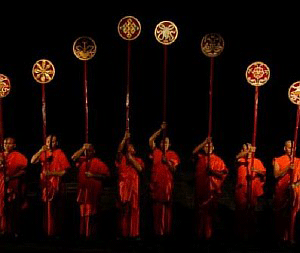BEIJING: For the first time, Chinese audiences are being exposed to an Indian play showing the crucial moment of history that led to the spread of Buddhism across different countries including China. The play “Uttar Priyadarshi” depicting the story of Ashoka by celebrated stage director Ratan Thiyam is being staged in three Chinese cities as the inaugural offering for the Festival of India in China.

The drama with a 40-member cast saw a second performance to rapt audiences in Beijing at the prestigious Forbidden City Concert Hall the next day, and will soon be held in the cities of Guangzhou and Wuhan. This is the first time an important drama group from the North East is performing in China.
Thiyam’s Chorus Repertory Theatre is giving Chinese audiences a different view of India to Chinese audiences, who are mostly fed with the typecast image of fun dancing culture shown in Bollywood movies. This is a more serious and reflective image of India, which generated philosophical thoughts that commands influence over one-third of the world.
“This is really a contemporary play that discusses the issues of violence, terrorism and arrogance of power, which plague mankind today. The play is meant to awaken a strong desire for peace to counter the forces of violence,” Thiyam told TNN in the green room of the theatre.
But a large section of the audience wanted to be entertained instead of being bothered with serious retrospection by the boisterous scenes of the Kalinga war, the heart rending cries of widows, Ashoka’s repentance and adoption of Buddhism.
“Most of the Chinese audience went to the program hoping to enjoy Indian dance and music. We would have been happy if there was a little more dancing and music in the play,” Wang Shuying, retired professor of Hindi, said. “Also, the story of Ashoka should have been narrated in the local language at the beginning of the play as most Chinese know very little about it,” he said.
Thiyam looks at the issue of language differently. “My actors speak Pali, Manipuri and a kind of non-language that involves emitting a range of emotional sounds. Many Indians do not understand the languages used in this play. The idea is to convey the feeling and the message,” he said.
The drama, based on a poem by Ajneya, is also a rare exposition for Chinese audiences about how Indian actors can communicate through body rhythm as they play the roles of the king, the devil, monks, soldiers and widows. Changing sets in different scenes of the drama also speak a language of their own.
By Saibal Dasgupta
Source:http://timesofindia.indiatimes.com




